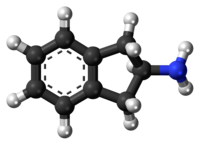2-Aminoindane (2-AI) is an aminoindane and research chemical with applications in neurologic disorders and psychotherapy that has also been sold as a designer drug.[1] It acts as a selective substrate for NET and DAT.[2][3]
 | |
 | |
| Clinical data | |
|---|---|
| Other names | 2-Indanylamine; 2-Indanamine |
| Routes of administration | Oral |
| ATC code |
|
| Legal status | |
| Legal status |
|
| Identifiers | |
| |
| CAS Number | |
| PubChem CID | |
| ChemSpider | |
| UNII | |
| CompTox Dashboard (EPA) | |
| ECHA InfoCard | 100.019.111 |
| Chemical and physical data | |
| Formula | C9H11N |
| Molar mass | 133.194 g·mol−1 |
| 3D model (JSmol) | |
| |
| |
| | |
Therapeutic and illicit uses
Synthetic aminoindanes were originally developed in the context of anti-Parkinsonian drugs as a metabolite of rasagiline and as a tool to be used in psychotherapy. Deaths related to their toxic effects have been observed both in the laboratory in animal studies and in clinical encounters.[4]
2-AI is a rigid analogue of amphetamine and partially substitutes for it in rat drug discrimination tests.[5][6] Other related homologues and rigid analogues of amphetamine include 2-aminotetralin (2-AT), 2-amino-1,2-dihydronapthalene (2-ADN), 1-naphthylaminopropane (1-NAP), 2-naphthylaminopropane (2-NAP), 1-phenylpiperazine (1-PP), 6-AB, and 7-AB.[6][5][7]
Chemical derivatives
There are a number of notable derivatives of 2-aminoindane that exist, including:
A number of notable derivatives of 1-aminoindan, a positional isomer of 2-aminoindan, also exist, such as rasagiline and ladostigil, among others.
Jimscaline, 2CB-Ind, and AMMI are derivatives of 1-aminomethylindane, an indane- and amine-containing compound related to 1-aminoindan.
Pharmacology
| Compound | Monoamine release (EC50, nM) | ||
|---|---|---|---|
| Serotonin | Norepinephrine | Dopamine | |
| 2-AI | >10000 | 86 | 439 |
| MDAI | 114 | 117 | 1334 |
| MMAI | 31 | 3101 | >10000 |
| MEAI | 134 | 861 | 2646 |
| Notes: The smaller the value, the more strongly the compound produces the effect. See also Monoamine releasing agent § Activity profiles for a larger table with more compounds. | |||
Legal status
China
As of October 2015 2-AI is a controlled substance in China.[9]
Finland
Scheduled in the "Government decree on psychoactive substances banned from the consumer market".[10]
Sweden
Sweden's public health agency suggested classifying 2-AI as a hazardous substance, on June 24, 2019.[11]
United States
2-Aminoindane is not scheduled at the federal level in the United States,[12] but may be considered an analog of amphetamine, in which case purchase, sale, or possession could be prosecuted under the Federal Analog Act.
References
External links
Wikiwand in your browser!
Seamless Wikipedia browsing. On steroids.
Every time you click a link to Wikipedia, Wiktionary or Wikiquote in your browser's search results, it will show the modern Wikiwand interface.
Wikiwand extension is a five stars, simple, with minimum permission required to keep your browsing private, safe and transparent.
